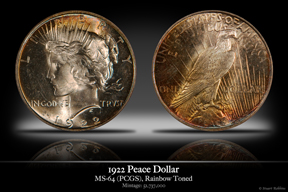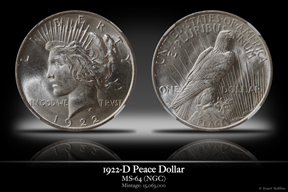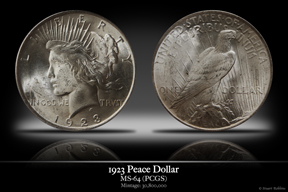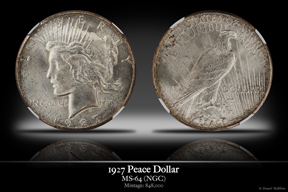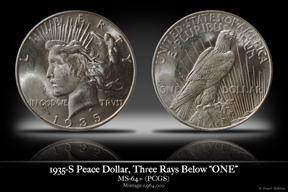Peace Dollar Series, Business Strikes
Overview of the Series
Peace dollars were the first dollar coin exclusively minted in the 20th century and the first and only coin to try to portray the idea of "peace" on a regular-circulating US coin. The idea came out of the US's involvement in World War 1 which had just ended a few years earlier.
The Peace dollar was struck from 1921 through 1935, but it was not struck between 1929 and 1933 due to the Great Depression. It is a fairly short series, a nice series, but being 1 ounce non-modern silver, it is not cheap. Mint marks are unusually tiny and appear on the reverse above the eagle's tail.
Coins in the Set
There are 24 business-strike coins in the series, and proof versions were also struck in 1921 and 1922 (in 1922, both in high and normal relief). So whlie there are technically 27 coins in the set, the proofs sell for 10s to 100s of thousands of dollars, so most consider this a 24-coin set without varieties.
Keys to the Series
A key to the series that most people think of is the 1921 high-relief version. This coin was only minted in 1921 and is a nice coin, provided you can find a good example of it (see issues below on strike). However, I would not consider this a "key" coin as many survived and it is relatively easy to obtain.
Keys come later on. The true key date/mints are the 1928 (Philadelphia) and 1934 S coins. Looking at the mintages, one would think it harder to obtain the 1928 because it is the lowest mintage for the series at 360,649 coins -- less than half of the next-lowest, the 1927 at 848,000 and 1927 S at 866,000 coins. However, it's really the 1934 S, at 1,011,000 coins that most collectors agree is the hardest to obtain. At auction, you can expect to pay around 4x more for the 1934 S than a 1928 example.
Things to Watch in This Series
Color: These coins are large and silver. They tone. Most toning on these that I have seen give them an overall yellow cast, though I have seen numerous significantly less attractive ones with splotches of dark toning in various places on either side.
Bag Marks: Again, these are large and they present a lot of space for bag marks. Silver is also relatively soft and will "scuff" more easily than the modern materials used for coins. Finding a specimin without bag marks that detract from the overall coin makes finding a nice example fairly difficult.
Strike: The Mint realized in 1921 that the design of these coins was difficult to strike well, hence why they lowered the relief in 1922. But even then, worn dies, poor technique, or just laziness all contributed to fairly poor strikes. What you should watch for is Liberty's hair. A poor strike will show very little hair detail, pretty much all over, but especially apparent in the bun and the hairs near the ear / cheek. I recommend waiting to buy until you find a coin that shows good hair detail. But, keep in mind you will likely need to pay a premium for that, and you are much less likely to find them in later years (for example, every 1935 example I've seen has pretty much no hair detail in the strands that drape over the cheek).
Die Cracks: Not to be confused with bag marks or an odd strike, the large dies used to strike Peace dollars (and for that matter, Morgan dollars) would often crack but not be replaced. These cracks would be reflected as positive-relief features on the final coin and are found frequently. In fact, there is a sub-specialty of collecting Peace dollars and even a "top 50 VAMs" for Peace dollars ("VAM" stands for "Van Allen - Mallis" after the two men who first extensivley studied and cataloged them), though not all VAMs are due to the die cracks. Sometimes, the VAM attribution, such as the famous 1923 VAM-1A "Wisker Jaw" will be included by a third-party grading service on the slab.
My Collecting Goal
My broad, slow goal for this series is a MS-64 collection with a few in lower grades (as discussed above). The series is expensive, somewhat lowish mintages and even lower survival rates. And even fewer coins that actually look good. A pure MS-64 set would cost around $16,000. Mine should come in closer to $7,000, over several years of collecting.
A Note on the Photographs: Because I'm collecting these in PCGS slabs, it is very difficult to take good photos of the coins because (1) I'm photographing through thick plastic, and (2) that plastic is scratched and has dust that accumulates no matter how many times I wipe it off. So keep in mind that the actual coins look better than the photographs make them out to be.
Checklist
| DATE | HAVE? | GRADE |
| 1921 | ||
| 1922 | YES | MS-64 |
| 1922 D | YES | MS-64 |
| 1922 S | ||
| 1923 | YES | MS-64 |
| 1923 D | ||
| 1923 S | ||
| 1924 | ||
| 1924 S | ||
| 1925 | ||
| 1925 S | ||
| 1926 | ||
| 1926 D | ||
| 1926 S | ||
| 1927 | YES | MS-64 |
| 1927 D | ||
| 1927 S | ||
| 1928 | ||
| 1928 S | ||
| 1934 | ||
| 1934 D | ||
| 1934 S | ||
| 1935 | ||
| 1935 S | YES | MS-64+ |
